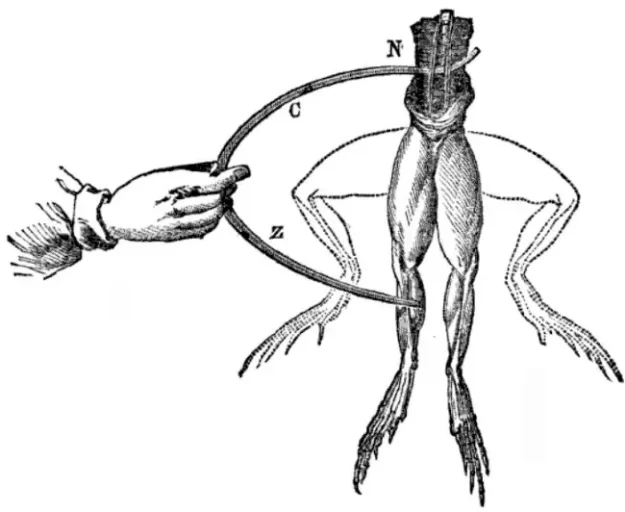Mary Shelley didn’t invent Frankenstein out of thin air. When she began writing her novel in 1816, science was pushing the boundaries of life, death, and electricity — and she was paying close attention. Her tale of Victor Frankenstein, a science student obsessed with reanimating the dead, grew directly out of the discoveries and debates of her time. Here are five influences that sparked her imagination.
1. The Spark of Life: Galvani’s Twitching Frogs 🐸
In the 1780s, Italian scientist Luigi Galvani discovered that a frog’s leg would twitch when touched with an electrical current. He called this mysterious force “animal electricity,” and it raised a provocative question: if a spark could jolt a frog into motion, what might it do to larger creatures?
📜 The illustration at the top of this page shows Luigi Galvani’s famous frog-leg experiment. By touching muscle tissue with copper and zinc, he created an electric current that made the legs twitch — a phenomenon known as “galvanism.”
2. Raising the Dead: Aldini’s Shocking Corpses ⚡
Galvani’s nephew, Giovanni Aldini, took the idea further — and into the public eye. In the early 1800s, he staged demonstrations using the bodies of freshly executed criminals. Onlookers reported limbs jerking, jaws clenching, even eyes rolling. One infamous display in 1803 involved the corpse of George Forster, a convicted murderer, and left London society shocked—and horrified.
These experiments suggested that electricity could mimic — or maybe even restore — the spark of life. Aldini’s dramatic displays fueled a growing curiosity about science’s power over nature.
3. Science on Stage: Davy’s Dangerous Chemistry 🧪
Meanwhile, British chemist Humphry Davy was dazzling audiences at the Royal Institution in London. Mary Shelley and her father, William Godwin, attended some of his lectures, where they saw gases ignite and wires glow with electricity. Davy explored the fundamental forces of nature, and his ideas about chemistry’s potential to unlock life’s mysteries inspired Shelley. His charismatic showmanship made science feel thrilling—and a little dangerous—planting seeds for Frankenstein’s bold vision of pushing scientific boundaries.
4. The Great Debate: Vitalism vs. Mechanism 💡
Beyond the laboratory, a fierce philosophical debate was unfolding: what is life?
- Vitalists believed life required a special “spark” or force beyond chemistry and physics.
- Mechanists argued that living organisms were simply intricate machines.
Shelley’s novel dives straight into this debate. Is life sacred and untouchable, or can human hands re-engineer it? Victor Frankenstein’s hubris dramatizes the mechanist dream taken too far.
5. Ancient Dreams: The Shadow of Alchemy 🔮
While Shelley rooted her story in modern science, she also drew on older traditions. Alchemists like Paracelsus had long dreamed of creating artificial life. Victor Frankenstein’s secretive midnight experiments echo those occult roots — blending alchemy’s mysticism with the rigor (and arrogance) of emerging science.
From Sparks to Science Fiction ✨
Together, these influences created fertile ground for Shelley’s imagination:
- Galvani and Aldini showed how electricity could jolt dead matter.
- Davy revealed the spectacle — and danger — of modern science.
- Vitalism vs. Mechanism gave her the philosophical core.
- Alchemy provided the gothic atmosphere of forbidden knowledge.
Shelley wove these threads into Frankenstein, a story that blurred the line between science and the supernatural. She envisioned a scientist bold (and reckless) enough to reanimate the dead — and gave us one of the most enduring stories of all time. The result wasn’t just a novel. It was the birth of a whole new kind of storytelling: science fiction.
Further Reading
- On Galvanism: Learn more about the real-life “Dr. Frankenstein” and the electrifying experiments that inspired the novel in this article from Discover Magazine: “Giovanni Aldini: This Real-Life Dr. Frankenstein Electrified the Dead”
- On Humphry Davy: Discover the life and lectures of chemist Humphry Davy at the Royal Institution‘s website, where he worked and lectured: “Sir Humphry Davy (1778–1829)”
- On Vitalism vs. Mechanism: This philosophical debate was central to the early 19th century and the novel. For more detail, read about how the debate influenced Shelley’s work: “The Implications of Synthetic Biology: A Brief Historical Reflection”
